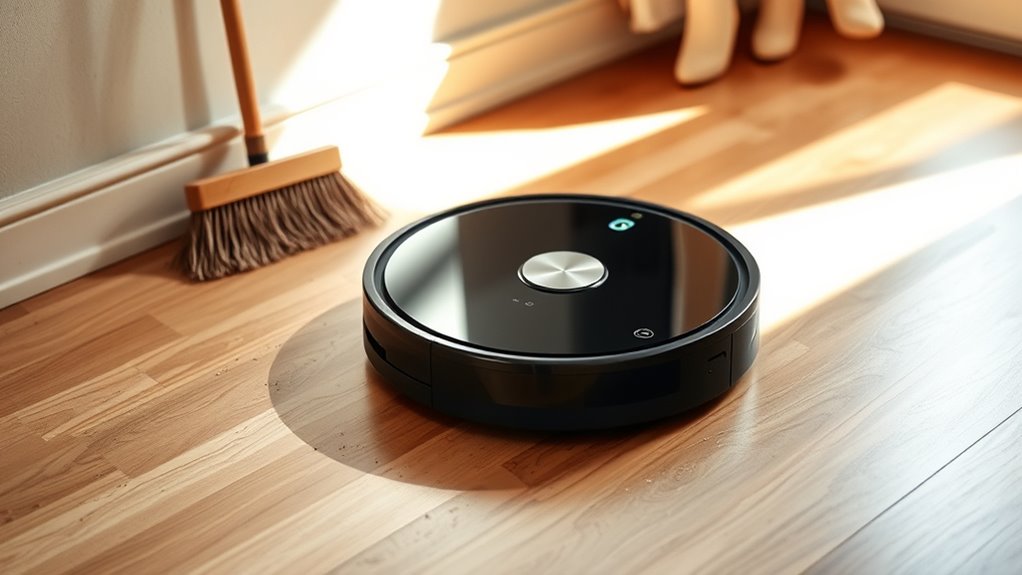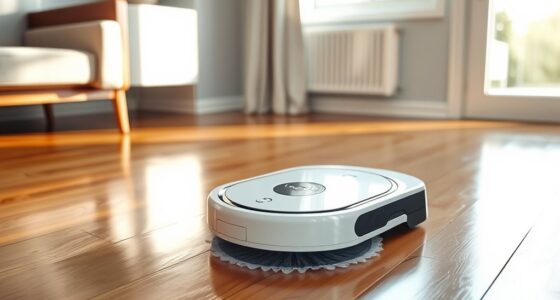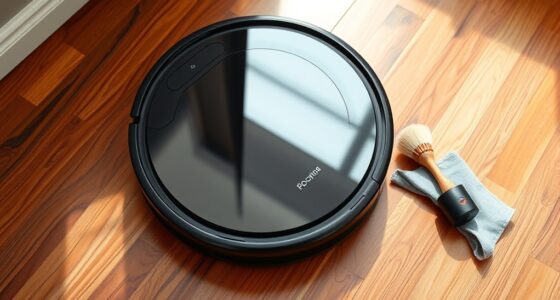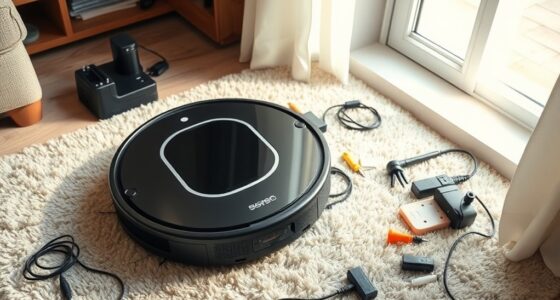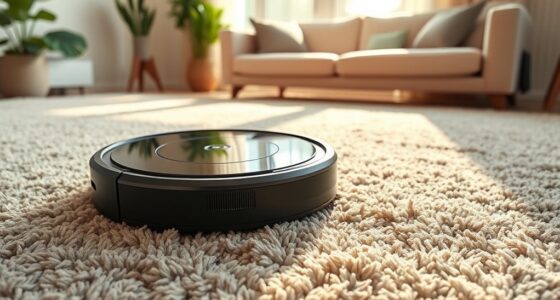Robot vacuums are great for everyday dust, pet hair, and small debris on hard floors, but they can’t fully replace manual sweeping. They excel at maintaining general cleanliness but struggle with stubborn, heavy, or tucked-away messes, especially in tight corners. Proper maintenance and smart use extend their performance, yet some cleaning tasks still require your manual effort. To discover how to get the most out of both methods, stay tuned for more helpful insights.
Key Takeaways
- Robot vacuums effectively handle everyday dust, pet hair, and small debris on flat, hard floors.
- They struggle with heavy, sticky, or tucked debris requiring manual sweeping.
- Manual sweeping is still needed for corners, edges, and stubborn or larger debris.
- Proper maintenance and charging habits improve robot vacuum cleaning efficiency.
- Combining both methods ensures thorough cleaning and maintains overall floor hygiene.

Robot vacuums have revolutionized how many people keep their homes clean, but manual sweeping still plays an essential role in certain situations. While these devices are great for everyday maintenance, understanding the importance of proper robot maintenance and monitoring the battery lifespan is vital for peak performance. Regularly checking your robot vacuum ensures it runs smoothly and extends its longevity, saving you time and money in the long run. If you neglect maintenance, the device’s cleaning efficiency drops, and you may find yourself needing to sweep more frequently to compensate for missed spots or stubborn dirt.
Battery lifespan is particularly vital because it directly affects your robot vacuum’s ability to complete tasks without interruptions. Most models rely on rechargeable batteries that degrade over time, reducing run time and cleaning power. When your robot starts shutting down prematurely or struggles to finish cleaning sessions, it could be a sign that the battery needs replacement or that you need to optimize charging habits. Properly charging your vacuum—avoiding frequent full discharges or leaving it plugged in constantly—can help prolong battery health. Also, keeping the device’s brushes and filters clean prevents strain on the motor, which, in turn, helps conserve battery life.
Maintaining battery health by proper charging and cleaning brushes extends your robot vacuum’s lifespan and efficiency.
Despite their impressive capabilities, robot vacuums aren’t always able to replace manual sweeping entirely, especially on hard floors with debris that’s heavy, sticky, or tucked into corners. They excel at picking up dust, pet hair, and small particles on flat surfaces, but larger or more stubborn debris may require manual intervention. In addition, tight corners or edges can be difficult for these devices to reach effectively, making traditional sweeping or spot cleaning necessary. For thorough cleaning, you might still need to break out the broom or dustpan occasionally, particularly after gatherings or when dealing with messes that require more force or precision.
In essence, a robot vacuum can greatly reduce your cleaning workload and maintain a general level of cleanliness on hard floors. However, it’s not a complete substitute for manual sweeping in every situation. Maintaining your robot vacuum through regular robot maintenance and keeping an eye on the battery lifespan ensures it performs at its best, but knowing its limitations means you’ll also recognize when manual cleaning is needed. Additionally, choosing the right type of robot vacuum can make a significant difference in coverage and effectiveness. Combining both methods provides the most comprehensive approach to keeping your hard floors spotless, allowing you to enjoy cleaner spaces with less effort while acknowledging the strengths and boundaries of your robotic helper.
Frequently Asked Questions
How Do Robot Vacuums Handle Large Debris on Hard Floors?
Robot vacuums handle large debris by using powerful suction and specialized brushes, but they may struggle with very large objects. For debris pickup, they work best with small to medium particles, while large object handling can sometimes require manual intervention. You should clear big debris before vacuuming or opt for a model with strong suction and good obstacle detection. This guarantees efficient cleaning without getting stuck or missing debris on your hard floors.
Are Robot Vacuums Effective on Uneven or Textured Surfaces?
Imagine a robot vacuum maneuvering your uneven or textured floors, its sensors constantly adjusting for surface differences. You might wonder if it can truly handle such challenging surfaces. In reality, with advanced sensor accuracy and surface adaptability, many models effectively clean textured areas. They detect changes, adapt their cleaning patterns, and maintain thoroughness. While not perfect for every rough patch, modern robot vacuums do a surprisingly good job on uneven floors.
Can Robot Vacuums Clean Under Low Furniture Better Than Manual Sweeping?
You’ll find robot vacuums excel at cleaning under low furniture because of their slim profiles and precise navigation. They easily handle furniture clearance and can access tight spaces that manual sweeping might miss. While sweeping is good for stubborn debris, a robot vacuum efficiently tackles cleaning obstacles in hard-to-reach areas, making your cleaning routine more convenient. So, in many cases, they outperform manual sweeping for under-furniture cleaning.
Do Robot Vacuums Require Regular Maintenance for Optimal Performance?
Your robot vacuum’s performance depends on regular maintenance, or it’ll turn into a stubborn dirt magnet! You gotta keep the battery life charged and the brush maintenance on point—think of it as giving your tiny cleaning robot a spa day. Neglect these, and it’ll struggle to clean effectively, leaving you to do the manual work. With proper upkeep, your robot vacuum will keep your floors spotless effortlessly!
How Do Robot Vacuums Perform in Homes With Pets and Fur?
In homes with pets, a robot vacuum handles pet hair and fur accumulation well, but it might not catch every strand in tight corners or under furniture. You’ll find it helpful for daily cleaning, reducing manual sweeping. However, for thorough cleaning, especially with heavy fur buildup, occasional manual sweeping or deep cleaning might still be necessary to guarantee all pet hair is removed.
Conclusion
While robot vacuums can efficiently handle daily dirt and dust, they can’t fully replace manual sweeping. They clean floors, but they don’t replace the detailed attention you give during manual sweeping. They save time, but they don’t replace your personal touch. They automate tasks, but they can’t replicate your care. Ultimately, robot vacuums complement your cleaning routine, but they don’t replace your effort, your presence, or your commitment to a truly clean space.
